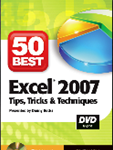I began to post my videos as podcasts at the iTunes store this past summer. Since then, my video lessons for Excel and PowerPoint have been viewed and downloaded many times. I am thirlled. And, I thank you for your support and encouragement.
Here are the links – on my website – to the most popular video episodes. I have organized them by category in the order of their popularity. You can click on any link to view or download that video from my website. Or, you can go to my video Podcast by clicking on this link – “Danny Rocks Tips and Timesavers” Podcast on iTunes.
Merging and Consolidating Excel Worksheets
PowerPoint Presentations
- How to Display Numbers During a PowerPoint Presentation
- How to Animate SmartArt Diagrams in PowerPoint
Data Visualizations
What-If Analysis in Excel
- Perform Break-Even Analysis with Excel’s Goal Seek Tool
- Use an Excel Data Table to to See the Effect on Multiple Formulas
Importing Data From Other Programs
Pivot Tables
- How to Show a Year-to-Year Comparison Report in a Pivot Table
- Show Percentage of Total Calculations in a Pivot Table
- Dynamically Expand the Source Data for Pivot Tables in Excel 2007
- Create a Month, Quarter, Year Report with 10 Mouse Clicks in a Pivot Table
Excel Tables
Social Media
Formula Errors
Please add your comments below – or on my iTunes Channel. I welcome your feedback.
You can learn how to “Master Excel in Minutes – Not Months!”
Sincerely,
Danny Rocks





How to Annotate Excel Worksheets with Comments and Images
Do you use “post-it” sticky notes to remind you how to do something? Do you ever lose your reminder notes? I know that I do! So that is why I like to annotate my Excel Worksheets with Comments – this way I have the notes properly located (in the worksheet) when I need them (to remember how to write a particular formula, etc.) the most!
In this lesson, I also show you how to add “pictures” inside your comments. This is a great tip for adding in a picture for a catalog or order form.
A question that I am frequently asked: “How do I print out my comments?” Watch this video to find out how to do this – there are a couple of “got’cha” steps involved.
The 50 Best Tips
Here are three ways to enter a new comment that is attached to a single cell:
You can edit your comments, re size the shape of your comments, hide your comments (only a “red triangle” shows in the cell until you hover near the cell), show your comments (individually or collectively), delete, clear and paste your comments. I cover each of these techniques in this video lesson. And more!
Watch this video in High Definition, Full Screen Mode on my YouTube Channel – DannyRocksExcels
Learn how to “Master Excel in Minutes – Not Months!”